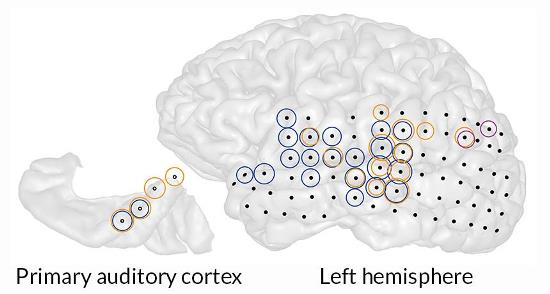Phantom sounds plaguing people with tinnitus affect a much larger swath of the brain than normal sounds do, a new study finds.

Ghostly ringing: A phantom noise prompted widespread changes in brain activity (circles; colours represent different frequencies of nerve cell activity) in the left side of a man’s brain, including the primary auditory cortex. The black dots represent electrodes implanted in his brain.
The results, published in Current Biology, offer a clearer view of how brains respond to sounds of their own making.
As part of his treatment for epilepsy, a man with tinnitus had electrodes implanted under the left side of his skull, creating a rare opportunity to study how the brain handles internally created sounds.
Neuroscientist William Sedley of Newcastle University in England and colleagues used specially calibrated white noise to curb the man’s tinnitus, a treatment that worked only occasionally. The researchers then compared brain activity when the white noise quieted the tinnitus with brain activity when the white noise was ineffective.
A surprisingly wide expanse of the brain handled the tinnitus sound, Sedley says, a pattern quite different from the small brain area that helps detect regular sounds. A clearer understanding of how the brain responds to tinnitus might ultimately lead to better ways to hush the noise.
Further reading: Meniere’s Disease
Reference:
